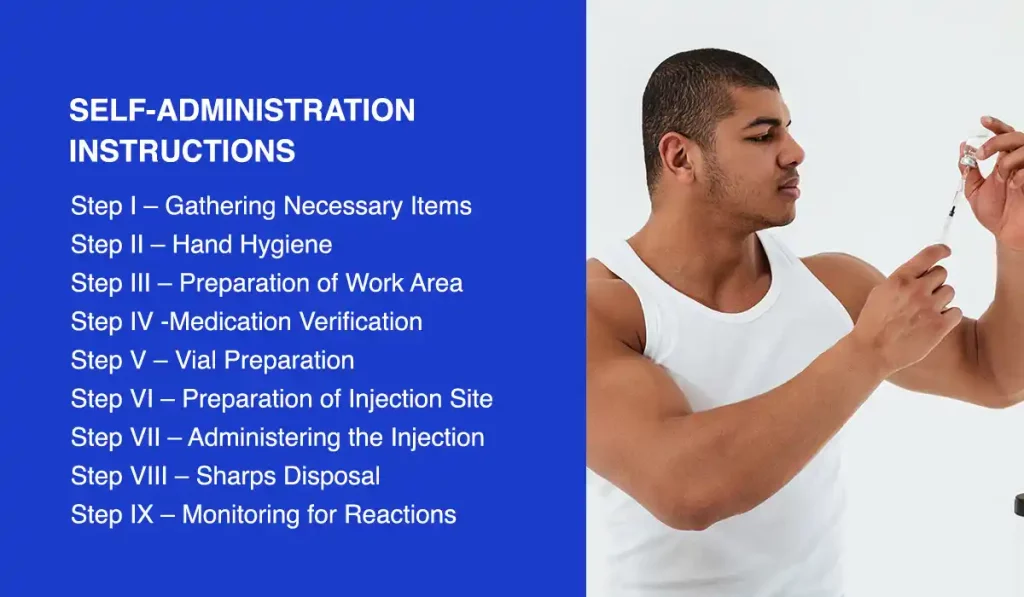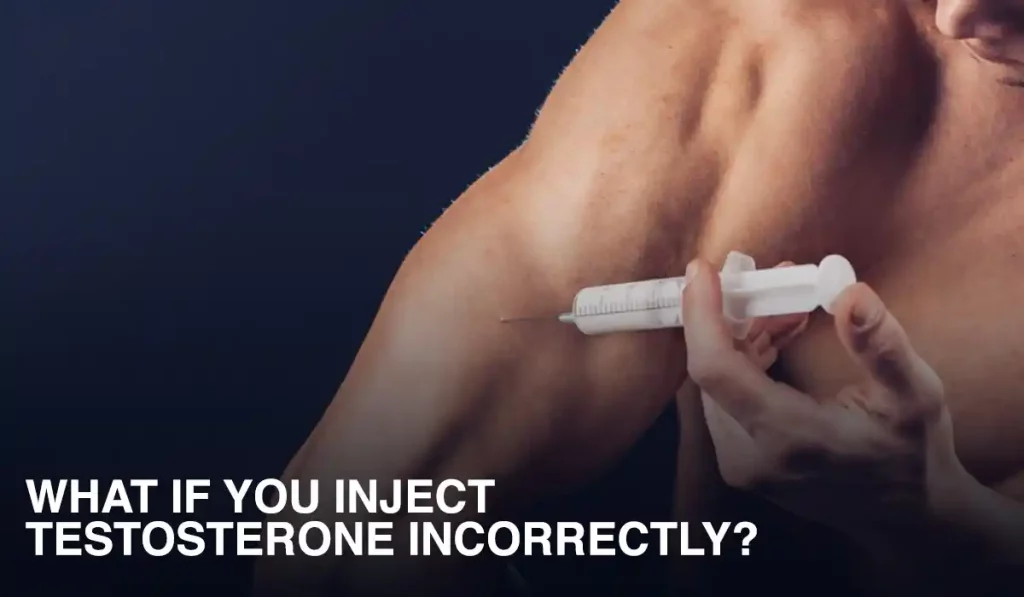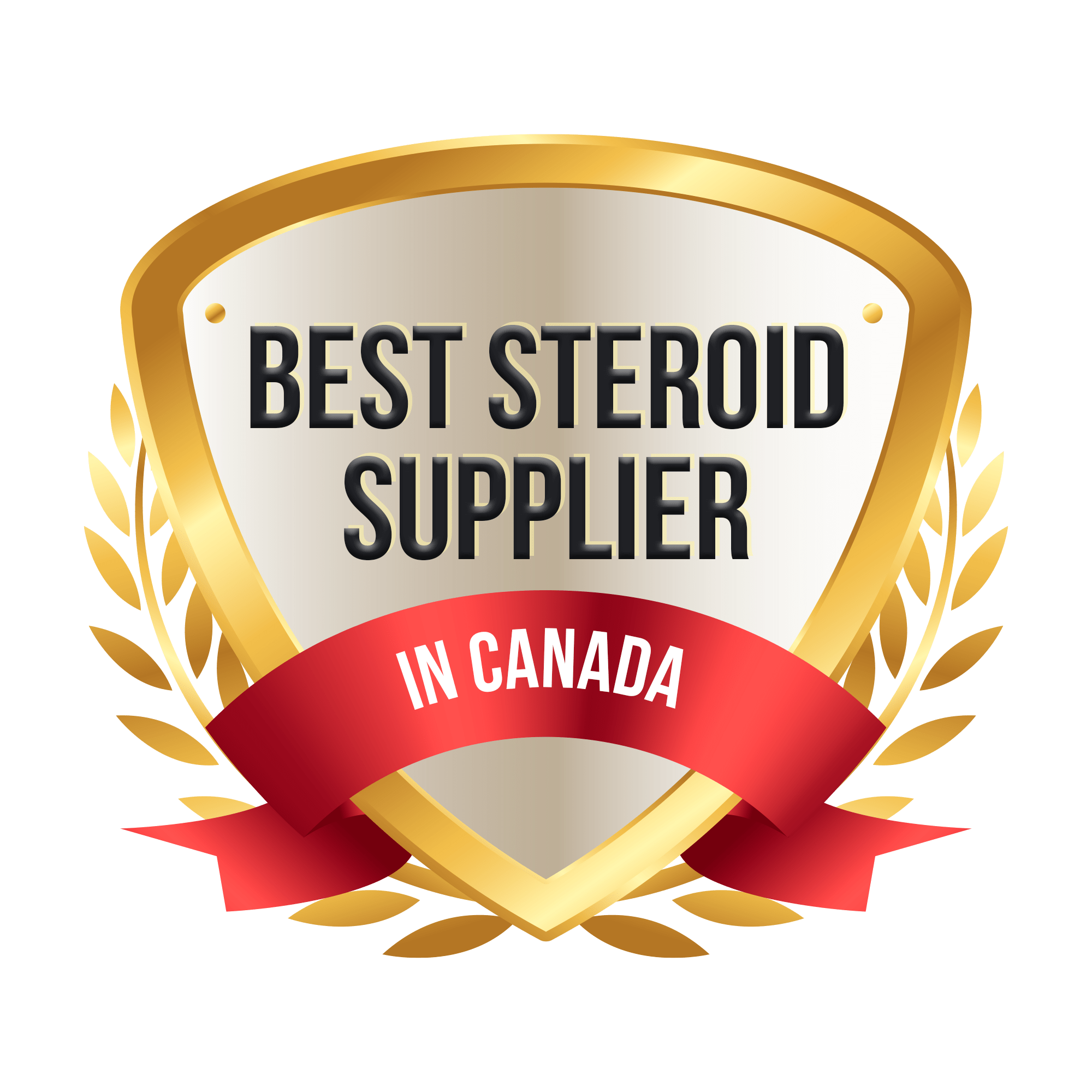Testosterone is a vital hormone produced in the testicles (male) or ovaries (female). It is essential for developing male reproductive tissues and maintaining distinctive male traits. Testosterone is important for muscle mass, bone density, energy levels, and sexual function in both men and women.
Self-injection is a simple and convenient way for individuals to manage their medication and take control of their health. It allows people to administer their own medication, giving them more independence and autonomy.
Instructions for self-administration Testosterone IM injection

Self-administration of testosterone intramuscular (IM) injections is a routine aspect of testosterone replacement therapy or testosterone shots. Follwoing these instructions ensures a smooth and secure administration process.
Here are the steps required for self-administration of testosterone IM injection:
- Step I – Gathering Necessary Items: Ensure you have the required supplies: testosterone vial, sterile alcohol swabs, syringe, needle (as prescribed), and a sharps container.
- Step II – Hand Hygiene: Wash your hands thoroughly with soap and water to minimize the risk of infection.
- Step III – Preparation of Work Area: Select a clean and well-lit area for the injection process. Have a stable surface for the vial and syringe.
- Step IV -Medication Verification: Check the medication details on the vial, including the name, concentration, and expiration date. If in doubt, consult your healthcare provider.
- Step V – Vial Preparation: Clean the vial’s rubber stopper with an alcohol swab, then draw air into the syringe, injecting it into the vial to equalize pressure. Invert the vial and withdraw the prescribed dose, ensuring the absence of air bubbles.
- Step VI – Preparation of Injection Site: Choose an appropriate injection site, typically the thigh or buttock, and clean the injection site with an alcohol swab and let it air-dry.
- Step VII – Administering the Injection: Hold the syringe like a dart, insert the needle at a 90-degree angle, and then gradually push the plunger to administer the medication. Withdraw the needle at the same angle it was inserted.
- Step VIII – Sharps Disposal: Immediately place the used syringe and needle into a designated sharps container for safe disposal.
- Step IX – Monitoring for Reactions: Be vigilant for adverse reactions such as swelling, redness, or pain at the injection site. Notify your healthcare provider promptly if you experience unusual symptoms.
If you are planning to take Testosterone orally read this: How to Take Testosterone Orally
Mistakes to avoid while giving yourself a testosterone shot
There are six mistakes you should avoid while giving yourself a testosterone shot. It includes inadequate training, not sterilizing and maintaining hygiene, wrong needle size and gauge, not rotating injection sites, ignoring allergic reactions, and inconsistent dosage schedules.
- Inadequate Training: A fundamental error is self-administering testosterone injections without proper training. Seeking guidance from a healthcare professional is essential to understand injection techniques, site selection, and accurate dosages. Trying injections without adequate training may lead to inaccurate dosing or other complications.
- Not Sterilizing and Maintaining Hygiene: A sterile environment during injections is vital to prevent infections. Failing to clean the injection site, hands, and equipment properly can introduce bacteria and increase infection risks. Always adhere to recommended hygiene practices, including thorough handwashing and sterilized equipment.
- Wrong Needle Size and Gauge: Choosing the right needle size and gauge is critical for a successful injection. Using a needle that is too short or thick may result in inadequate penetration or increased pain. Consult a healthcare professional to determine the appropriate needle size and gauge based on individual needs and body composition.
- Not Rotating Injection Sites: Repetitive injections in the same spot can lead to tissue damage and pain. Regularly rotate injection sites to distribute the medication evenly and minimize complications. Common sites include the glutes, thighs, and deltoids. Keep a record of injection sites to ensure proper rotation.
- Ignoring Allergic Reactions: While rare, allergic reactions to testosterone injections are possible. Symptoms may include swelling, redness, itching, or difficulty breathing. If any signs of an allergic reaction occur, seek immediate medical attention. Ignoring these symptoms could lead to more severe complications.
- Inconsistent Dosage Schedule: Inconsistent dosage may delay the progress or show no progress at all. Consistency in injection administration is crucial for stable hormone levels. Skipping doses or irregular administration can cause fluctuations, leading to mood swings and fatigue. Adhere diligently to the prescribed dosage schedule.
Learn more about Testosterone dosage and cycle here: Ultimate Guide on Testosterone Cycle
What if you inject testosterone incorrectly?

Injecting testosterone incorrectly may result in complications such as infection, abscess formation, or inadequate absorption of the hormone, according to medlineplus.gov. It is essential to adhere to medical guidelines and consult with healthcare professionals to ensure the correct and safe administration of testosterone.
FAQs
What is an intramuscular injection?
An intramuscular injection is the direct delivery of medication into the muscle tissue through the use of a needle and syringe.
How deep should an intramuscular testosterone injection be?
An intramuscular testosterone injection should reach through a subcutaneous fat layer or 1.25 or 1.5 inches into the muscle.
Where is the appropriate intramuscular injection site for administering testosterone in the buttocks?
The appropriate intramuscular injection site for administering testosterone is the upper and outer quarter of the buttocks towards the hip bone area.
Where should testosterone be administered in the thigh?
Testosterone should be administered in the middle third on the outer edge of the thigh.
What is the appropriate needle gauge to inject testosterone?
The appropriate needle gauge for administering testosterone injections is 22-23 gauge.
What is the optimal body part for intramuscular testosterone injections?
Thighs and hips are very important for intramuscular testosterone injections.
What happens if testosterone is not injected into the muscle?
If testosterone is not injected into the muscle, one may face severe complications like injection at the injection area and the risk of puncturing blood nerves and vessels.
Where is the appropriate location to administer a testosterone injection in the shoulder?
The appropriate location to administer a testosterone injection is in the bony point of the shoulder.



